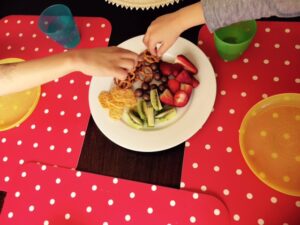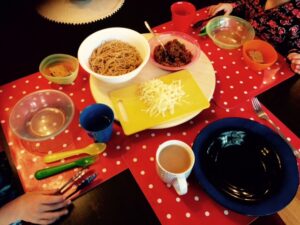
As you know I recently attended the 3 day Ellyn Satter Australian tour in early September looking at The Feeding Relationship and Eating Competence. The 3 days were great and I have preached her wise words particularly on the Division of Responsibility (DOR) for years. But I walked away with several questions running through my mind and realised, it was time to “live” it exactly as she preached (and not as I “tweaked” in real life). And what better place to start than with my kids, Mr 6 (cautious and occasionally fussy eater) and Mr 4 (adventurous and independent eater). I am always upfront with my patients, we have busy lives, my husband works long hours and often our “family meals” are not as often as we would like.
- The parent is responsible for what, when, where
- The child is responsible for how much and whether (they eat the meal)
So yes this means eating as a family around the table but what about the other aspects of DOR?
My role:
– Be structured about meals and snacks – tick
– Meals to be eaten together and at the table – need to work on this
– I decide what to serve (no short order cooking) but I must include foods that my children will eat – tick
Kids’ roles
– Decide whether they want to eat the foods I serve
– Decide how much of it they want to eat (so let’s be really clear here – this means no “eat 3 bites then you can finish”, “you have to try one bite of everything on your plate”, “you have to finish your main before dessert”). It blows me away when “DOR” friendly professionals advise this – any pressure on how much they eat it is not DOR!
Watching videos during Ellyn’s course left me with many “light bulb” moments and so I thought I would share some of my week of “real life” photos and videos with you to help you have your lightbulb moments as well….
My wonderful boys agreed to be actors in my first video to demonstrate what NOT to do or say at mealtimes. They are being super cheeky in this video which I adore….
You will notice in the video below that I did the following:
– Pre-plated (served up their food on their plates)
– Did not eat with them
– Look at their positioning: Facing the TV (which you can’t see) and on regular chairs – They both look so unstable and Mr 4 can’t even reach the table (sorry I’m not a camera saavy person and the video isn’t perfect – we had to reduce the quality to so my wordpress site could upload it)
– I use lots of negative language: you don’t even need the volume to watch this: I am pointing, standing up and leaning over them. I even took the control of eating from my 6 year old and tried to feed him (did you hear his comment? “really mum??”). Bless him, he trusted me enough to open his mouth and then promptly spat the salad out! Love it!
– Bribing is the big one I use – “clean your plate then you can have dessert”, “eat some of your salad and I will turn on the TV” (distractions), if you listen closely, they do start negotiating with me and if all else fails, Mr 4 starts acting up and running towards the ipad. He never does this in a meal and I don’t think it’s even the play acting that causes him to get up (twice), he’s feeling the pressure and trying to alleviate it.
Click on the video below to see a “not” Ellyn Satter style of eating:
Woosh, I’m stressed just watching the video and I stopped recording after 3 mins because I didn’t want to stress the kids out. After the video, they both got long deep cuddles and a thank you for helping me teach my patients “what not to do at mealtimes”. One thing I forgot to use was positive praise which is also considered (according to Ellyn Satter) as negative pressure eg “Well done Mr 6, you ate your carrot – look Mr 4, how great is Mr 6, he ate his carrots”. The enjoyment should be in the meal itself and communication around the meal not the praise for actually eating it. According to the DOR (as listed above), it is their job to decide whether to eat it or not (and how much to eat), not mine….
SO PUTTING IN PLACE ELLYN SATTER’S NEW RULES….
Step 1: Explained to the kids that family meals will now be different:
– No TV or ipad at the table (including adults)
– All of the food will be placed in the middle of the table and everyone can serve themselves (as much or as little of anything they want).
– They don’t have to eat anything they don’t want to
– Their servings of dessert will also be on the table and they can eat their meal in any order they wise (this includes dessert first)
– They can leave the table when they want but when they do, it tells me that “they are full and are finished”. But this also means that they won’t be able to eat anything until the next meal. The kitchen is closed. Water is the only thing on offer. All meals and snacks are to be set and structured. They won’t starve waiting until the next meal.
Step 2: Revised the rules with my husband, mainly:
– We decide what is on the table in regards to variety of food
– We will always have a “safe food” eg bread, pasta or something we know the boys will eat
– We won’t comment on the food or put any pressure (positive or negative) on the kids so no more comments like “well done Mr 6, you ate your vegetables”, or “please eat your meat, it’s important for your body”.
– We will trust the kids’ appetite and won’t tell them to finish their plates, or eat one more bite (my absolute pet-peeve! – what does one more mouthful prove apart from being a battle of control) or bribe them with dessert.
– We will chat with them about their day and other topics eg what might be coming up or even higher level topics (within reason based on age) eg what is your favourite sport and why etc.
– We will have regular meals and snacks and sit down at the table together for every one of these… with no devices. If the phone rings, then we leave it. This mealtime matters and everything else can wait.
So before I show you my second video, here is the “intro” video to the key points (forgive me for the side shot… my husband always says to turn my phone around!!):
- Safe foods + family meal on the table
- Dessert on the table
- Good positioning for the kids
So here is my attempt at an Ellyn Satter family meal – “real life” – please know that it may not be “perfect” but it is my real life attempt…
Sorry for the video quality… I had to learn all about cropping and reducing video quality to get it small enough to upload onto my website. Hopefully it didn’t take too long to load….
So what did you think? Doesn’t that meal have a different vibe to the first one? You will notice:
– We all sat around the table facing each other (I can’t stress how important this is to model “happy eating”)
– All the food is in the middle and there were the following:
a) safe food: carbohydrates (soft and crunchy tacos) – they had unlimited access to this
b) protein: meat + beans and cheese
c) vegetables
d) dessert: in serving sizes so if they choose to eat dessert first, they can but if they are still hungry, they need to eat something else.
Ellyn talks about in her book “Child of Mine“, that it’s important to have foods that help body regulation (She terms them in American nutrition language: starch, fats etc but the concept is the same). She stresses the importance of having a range of food especially ones with “fats” in it eg have butter/margarine or avocado or cheese etc at the table as well as unlimited access to the safe foods.
– The boys were seated better (Mr 6 has a firm cushion on his chair with a stool for his feet whilst Mr 4 is sitting on a Mocka Soho chair)
– They are serving themselves (both have their own small sized tongs) and deciding what and how much they eat
– The focus of the meal is different as well. We are actually talking! I honestly can’t tell you what they put on their tacos because I wasn’t watching
They did really well (the giggles are when they forget to say Mr 4 or Mr 6 and used their real names.) So it’s not a 100% “real life” meal – they know they are being taped but this is my choice for this video because I’m trying to keep a bit of their privacy (my poor boys have had every step of their eating journey taped from birth – sad part of living with a mum as a feeding therapist!).
It was even my birthday during the first week of DOR (Bonus! see the sparkling red in the above photo!)…. So how did we go after a week? Well, you will have to wait until part 2 of this blog. You will notice that in the second video above the atmosphere is so much better although video 1 would not be a “normal” meal for us – we definitely play acted to draw out the biggest differences between pre and post DOR. I wanted you to see the “worst” in order to allow you to problem solve on what is working and what is not working in your family meal at home.
So what is my reality? while we do try to eat as a family (prior to this week), I often will pre-plate and let the kids eat at 5pm (I do sit with them and always have a cup of tea but I don’t eat dinner with them). Dessert is always the “second course” regardless of whether they finish their main meal and I just ask that my kids “eat until they are full”. I do often ask them to “learn” about the foods they don’t want to eat – so they can describe the colours, cut it up, smell it, lick it and if they are feeling ready, have a small taste. I have never forced my kids to eat something they don’t want to. This is my biggest mantra as a mum and therapist. “They don’t have to eat it but they do have to learn about it”. Not very Ellyn Satter… I know….
My husband doesn’t get home until 7 pm so we often eat after the children go to bed. I imagine that this is common in a lot of households. But Ellyn says we can do better and we need to start prioritizing meals over extracurricular activities and the chaos of families! So stay tuned for a week of family eating (no pre plating, no pressure to eat anything and the biggest change for us, one adult (ideally 2) eating with the kids. I can tell you upfront that I was surprised how subtle my pressure was – the kids started instructing each other to finish their main before dessert, their serving sizes surprised me and I just loved the conversations that occurred around the table. But what I really wanted to know was would they eat any vegetables if I didn’t push them? And what about families who have children with more restricted eating practices? Sensory issues? Autism Spectrum Disorder? Can DOR work for them? Stay tuned…
Until next time
Happy eating
Val
About the author of this blog post
Valerie is an Australian based Speech Pathologist with 13 years experience in Paediatric Feeding. She has recently opened a private practice called ‘Let’s Eat! Paediatric Speech Pathology’ that caters for Newcastle based babies and children with feeding difficulties. Valerie is passionate about working in the area of paediatric feeding and special needs and has been involved in the teaching and training of Australian Speech Pathology University students and allied health professionals. You can find out more about Valerie Gent and ‘Let’s Eat! Paediatric Speech Pathology’ via her website www.letseatspeech.com.au and Facebook page www.facebook.com/LetsEatPaediatric SpeechPathology or email her on valerie.gent@letseatspeech.com.au



